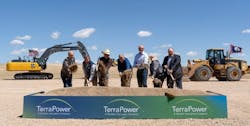Next-Gen Nuclear: TerraPower Breaks Ground on 345-MW Natrium Reactor Project
Some recent setbacks may have impeded small, advanced nuclear as a pathway to baseload, carbon-free power temporarily, but the industry celebrated a future-forward moment this week with a tech icon to cheer it on.
Next-gen nuclear startup TerraPower broke ground, ceremonially, Monday on its planned Natrium reactor demonstration project in Wyoming. The milestone is important as the first advanced reactor project to move from design to construction, although it’s five years away from completion.
The ultimate goal is a 345-MW sodium-cooled fast reactor with a molten salt-based energy storage system. Liquid sodium's boiling point is eight times higher than water, according to the demonstration project site.
TerraPower, which was founded by Microsoft co-founder and former CEO Bill Gates, would operate the plant as a commercial power generator once commissioned. The demonstration plant will be developed and operated in partnership with the U.S. Department of Energy.
Nuclear energy does not emit greenhouse gasses in generating electricity. Conventional-scale projects, however, have faced public opposition over radioactivity concerns and are extremely expensive to build, as evidenced by Georgia Power’s Vogtle 3 and 4 expansion totaling more than $32 billion.
Smaller nuclear innovators such as TerraPower, X-Energy and NuScale hope to reduce the time and expense by focusing on smaller footprints and becoming valuable in meeting the future GWs of capacity needed for data center and artificial intelligence facility growth.
“I believe that TerraPower’s next-generation nuclear energy will power the future of our nation—and the world,” Gates said in a statement released for the Monday groundbreaking. He attended and participated in the ceremonial event.
The headwinds vs. advanced nuclear are not much easier than conventional nuclear, either. NuScale Power gained federal design approval for its small modular reactor design and demonstration with the Idaho National Laboratory, but the project was scrapped when the municipal utility partner found it didn’t have enough subscribers to match revenue to costs.
Lingering memories of past nuclear disasters such as Chernobyl and Fukushima also surface repeatedly in public opposition.
Nonetheless, more and more environmentally minded tech giants such as Microsoft and Amazon Web Services are becoming nuclear-friendly as they see a conventional and renewable utility grid not ready for the sheer capacity of data center expansion. Some 21 GW of needed data center capacity is under construction with about 47 GW expected by the end of the decade, according to a recent report by Goldman Sachs.
This puts pressure on the commercial and industrial sector trying to connect environmental emissions goals with power resiliency requirements. Many are considering the possibility of nuclear-powered or nuclear-connected microgrids to power data centers.
“This groundbreaking represents the beginning of the next era of nuclear energy,” TerraPower President and CEO Chris Levesque said in a statement. “The natrium reactor is more than a design; it’s a plant coming to life that will support both the clean energy transition and our historic energy communities.”
The construction site in Kemmerer, Wyoming, is located near a retiring coal-fired power plant and is touted by the company as the only coal-to-nuclear project under development. The builders expect to employ about 1,500 construction jobs on the site.
Coal-fired electricity generation is the worst-emitting utility-scale resource currently in the power portfolio of the U.S. Nuclear energy, meanwhile, represents almost 20 percent of the mix and more than half of the carbon-free electricity generation, according to the federal Energy Information Administration.









